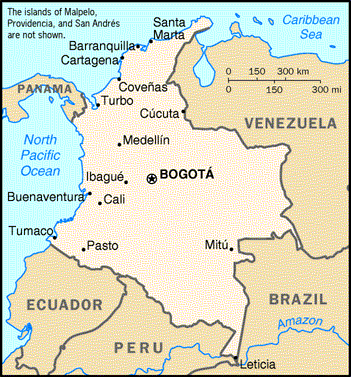

Status Quo Side: Colombian government
Non-Status Quo Side: M-19 movement
Region: Western Hemisphere
Conflict Type: Primarily Internal
Issues in Dispute: Governance
General Gustavo Rojas Pinilla's National Popular Alliance (NPA) party charged fraud after its close loss to the established Liberal and Conservative parties in the April 19 presidential elections.
NPA radicals stole the sword and epaulets of Simon Bolivar, famed Central American liberator, the first of many such stunts by the Movimiento de Abril 19, or M-19. On February 27 1980 M-19 raided an Embassy reception, holding 52 hostages including ambassadors under siege for 61 days of negotiations. The guerrillas then flew to Cuba with ransom money and the promise of an international commission to monitor human rights. In November 1982 President Belisario Betancur offered amnesty to 6 rebel groups including M-19. 900 political prisoners were freed and 1000 rebels turned in weapons. M-19 lost support by demanding further concessions. Continuing violence led to a signed truce on August 24 1984 to take effect in a week. The truce survived the assassination of a M-19 founding member and parliamentarian by the right wing. An armistice was negotiated, but charges of violations on both sides soon ended the truce.
M-19 raided the Palace of Justice in Bogota. The army, without Presidential consultation, laid siege. A day later the 100 dead included the Supreme Court President, 5 Justices, and all M-19 raiders, an event that spurred increased violence by rebel groups of left and right, drug traffickers, the military and police.
M-19 declared a unilateral cease fire. Against a background of extensive chaos and limited military gains, the government and M-19 reopened talks on April 1 1989. M-19 sought constitutional changes to break the ruling two-party coalition, an economic plan to help the poor and judicial reforms.
M-19 renounced violence and after the presidentail election became the third largest political party. M-19 leader Navarro Wolff opened talks with five other guerrilla groups to moderate their violent opposition, and entered the Cabinet. A popular vote on December 1990 gave M-19 the largest delegation to the convention to rewrite the 1886 constitution. M-19 lost electoral support as protest votes turned elsewhere. Other rebel groups remained active.
By 1996, guerrilla numbers resembled those of a decade earlier, but most were thought to seek the money to be made from kidnappings and extortion, and from guarding coca crops and drug factories, rather than social change. President Ernesto Samper, elected in 1994, established a peace commission to arrange peace talks, but his government was weakened by evidence of drug-related corruption involving the President himself. In July 1998, a month after being elected, President Andres Pastrana improved prospects for domestic peace by unprecedentedly meeting with the head of the leading Marxist rebel group. Peace talks became active again in 1999, but in 2000 the situation remained unstable, with substantial new US military aid in prospect.